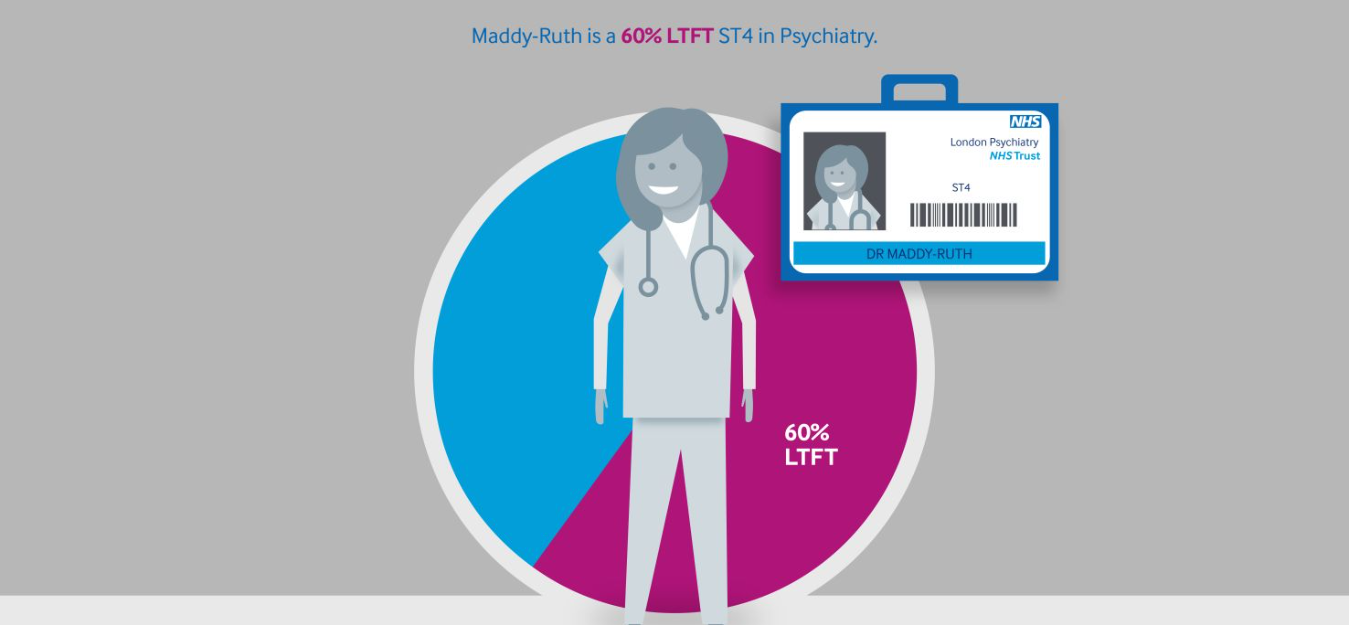 Maddy-Ruth is a 60% LTFT ST4 in psychiatry
Maddy-Ruth is a 60% LTFT ST4 in psychiatry
We will use the example of Maddy-Ruth to illustrate the guidance throughout.
You will need to use figures relevant to you in order to calculate your own pay.
Maddy-Ruth:
- is a 60% LTFT ST4 in psychiatry
- has a rota which places full-time trainees on one in four on-call
- has an LTFT on-call commitment of one in seven
- is on a work schedule where total full-time hours are 45 hours per week
- has a rota which places full-time trainees on 1 in 5 weekends
- has a LTFT weekend commitment of one in nine
- receives the £1,000 LTFT trainee annual allowance.
Basic pay
Basic pay is pro rata to the relevant nodal pay point for your grade, based on the proportion of full-time hours you will work. Your basic pay will be 1/40th of the relevant nodal point, multiplied by your average weekly hours, as per your work schedule.
How to work out your basic salary
- Use the most recent pay scale to find the basic salary for a full-time trainee at your nodal pay point.
Maddy-Ruth is an ST4. ST4s are at nodal point 4 - the basic salary for a full-time trainee at nodal point 4 is £49,036. - Divide this figure by 40 (because 40 is the number of hours which a full-time week is based on).
£49,036 / 40 = £1,225.90. - This gives you 1/40th of the basic annual salary for a full-time trainee. This is value A.
- Then, multiply value A by your average weekly hours. This is your basic annual salary.
Maddy-Ruth’s average weekly hours are 27. £1,225.90 x 27 = £33,099.3.
Weekend allowance
An allowance paid pro-rata to the value of the full-time allowance, based on your work schedule’s proportion of full-time commitment to the weekend rota – not your percentage of full time.
Work out what your weekend frequency is as a percentage of the full timers’ frequency. Then your weekend payment will be this percentage of the cash value of the full-time weekend frequency payment for your nodal point.
This is the same principle as LTFT on-call allowance.
NHS Employers have a weekend and on-call allowance ready reckoner that you can use to calculate your allowances.
How to work out your weekend allowance
- Find the percentage value of your LTFT commitment to the full-time weekend rota. This is done by dividing the total number of weekends in the full-time commitment by the total number of weekends in the LTFT commitment.
The full-time commitment on Maddy-Ruth’s rota is one in five weekends, and her LTFT commitment is one in nine weekends, meaning that Maddy-Ruth needs to divide five by nine (5/9= 0.5556 = 55.56%). - Multiply this percentage by the cash value of the weekend allowance given to a full-time trainee on the rota who is at your nodal pay point (see TCS schedule 2 paragraph 5 for a table detailing full-time allowance percentages, and the pay scales for different nodal pay points).
Maddy-Ruth is an ST4 working one in nine weekends. Her full-time colleagues are working one in five weekends.
This means that Maddy-Ruth’s full-time ST4 colleagues’ weekend allowance value is £2,828. Maddy-Ruth receives 55.56% of that. 55.56% x £2,828 = £1,571.24. - This is your weekend allowance per annum; divide it by 12 for the monthly amount.
On-call availability allowance
An allowance paid pro-rata to the value of the full-time allowance, based on your work schedule’s proportion of full-time commitment to the rota. The cash value of the 8% allowance is paid pro-rata to your proportional commitment to the full-time on-call rota. This is the same principle as LTFT weekend allowance.
A doctor is on-call when (s)he is required by the employer to be available to return to work or give advice by the telephone but is not normally expected to be working on site for the whole period. A doctor carrying an ‘on-call bleep’ whilst already present in the workplace as part of their scheduled duties does not meet the definition of on-call working.The 2016 TCS (terms and conditions of service)
This allowance is therefore only payable when a doctor is on call as per this definition.
NHS Employers have a weekend and on-call allowance ready reckoner that you can use to calculate your allowances.
How to work out your on-call availability allowance
- Find the percentage value of your LTFT commitment to the full-time on-call rota. This is done by dividing the total number of the full-time commitment by the total number of the LTFT commitment.
The full-time on-call commitment on Maddy-Ruth’s rota is one in four, and her LTFT commitment is one in seven (4/7= 0.5714 = 57.14%). - Multiply this percentage by the cash value of the on-call allowance given to a full-time trainee on the rota who is at your nodal pay point (see TCS schedule 2 paragraph 8; the full-time allowance is 8% of a full-time trainee’s basic salary. See the pay scales for cash value of this at different nodal pay points).
Maddy-Ruth is an ST4 working on-call one in seven , and her full-time ST4 colleagues are working one in four on-call.
This means that Maddy-Ruth’s full-time colleagues’ on-call allowance value is £3,923. Maddy-Ruth receives 57.14% of this (57.14% x £3,923 = £2,241.60). - This is your on-call allowance per annum; divide it by 12 for the monthly amount.
London weighting
A fixed sum, set out in the NHSE pay circular, paid pro-rata to LTFT trainees according to your agreed LTFT working percentage. This sum is not taken into account in the calculation of any other allowances or enhancements.
Please see 'London weighting' in section 6 of the junior doctors’ handbook to find out if your area qualifies.
How to work out your London weighting
- Find the London weighting sum for full-time trainees in the NHSE pay circular.
The full-time London weighting sum is £2,162. - Multiply this sum by your LTFT working percentage.
Maddy-Ruth is training as 60% LTFT trainee (£2,162 x 60% = £1,297.20). - This is your London weighting per annum; divide it by 12 for the monthly amount.
Annual allowance
All LTFT trainees are entitled to an annual allowance of £1,000.
This allowance is to recognise the relative increased costs of training that LTFT trainees face as a result of being less than full-time. It is for LTFT trainees only. It is paid in full and not pro-rated in any way.
Maddy-Ruth is working LTFT meaning she is eligible for the £1,000 LTFT allowance.
Flexible pay premia
Any flexible pay premia that apply to you, pro rata to your agreed proportion of full-time work. More than one flexible pay premia can apply at any one time, and they are in addition to the transitional pay premium.
How to work out your flexible pay premia
- Find the full-time sum of the flexible pay premia for which you are eligible in the NHSE pay circular.
Maddy-Ruth is an ST4 psychiatry trainee on a three year higher training programme. The psychiatry pay premia for full-time trainees, who are higher trainees and on a three year training programme, is £3,434. - Multiply this sum by your agreed LTFT percentage.
Maddy-Ruth’s agreed percentage is 60% (£3,434 x 60% = £2,060.40). - This is your flexible pay premia per annum; divide it by 12 for the monthly amount.

For almost 200 years, we have been supporting doctors from tuition to physician and beyond. Learn more about being a BMA member today.

